The diffusion dialysis membrane market is projected to grow from USD 237.7 million in 2025 to USD 362.1 million by 2035, expanding at a CAGR of around 4.3%, with growth distributed gradually across the forecast period. Year-on-year progression of the diffusion dialysis membrane market indicates a steady demand curve, where incremental annual gains rise from approximately USD 10–11 million in the early phase to nearly USD 14–15 million near the end of the forecast window. The period from 2025 to 2030 is expected to see the market increase to about USD 293.3 million, reflecting sustained adoption of diffusion dialysis systems in acid and alkali recovery operations within metal finishing, steel treatment, and chemical processing environments.
Rising environmental compliance requirements and increasing emphasis on waste minimization and closed-loop production cycles are reinforcing market stability. Beyond 2030, the pace of adoption gradually improves as membrane efficiency, chemical resistance, and operational lifespan enhancements reduce operating costs and strengthen return on investment for industrial users. Integrated control and monitoring systems that provide real-time performance data are becoming essential features, supporting predictive maintenance and process optimization.
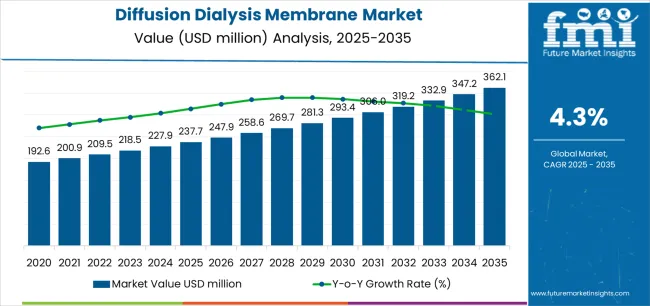
The latter half (2030-2035) will witness continued growth from USD 293.3 million to USD 362.1 million, representing an addition of USD 68.8 million or 55% of the decade's expansion. This period will be defined by mass market penetration of high-efficiency membrane technologies, integration with comprehensive process control platforms, and seamless compatibility with existing industrial infrastructure. The market trajectory signals fundamental shifts in how manufacturing facilities approach waste acid recovery and resource optimization, with participants positioned to benefit from growing demand across multiple recovery types and application segments.
| Period | Primary Revenue Buckets | Share | Notes |
|---|---|---|---|
| Today | New membrane sales (alkali, acid recovery) | 54% | Capex-led, facility-driven purchases |
| Membrane replacement and renewal | 26% | Periodic replacement, degradation replacement | |
| System integration and installation | 12% | Engineering services, system design | |
| Technical support and maintenance | 8% | Process optimization, troubleshooting | |
| Future (3-5 yrs) | High-performance membrane systems | 48-52% | Enhanced selectivity, extended lifespan |
| Replacement and lifecycle services | 24-28% | Predictive replacement, performance monitoring | |
| System optimization services | 16-20% | Process efficiency, recovery rate improvement | |
| Technical consulting | 10-14% | Application engineering, regulatory compliance | |
| Digital monitoring solutions | 6-8% | Real-time performance tracking, analytics | |
| Data services (recovery metrics) | 4-6% | Benchmarking for industrial operators |
At-a-Glance Metrics
| Metric | Value |
|---|---|
| Market Value (2025) | USD 237.7 million |
| Market Forecast (2035) | USD 362.1 million |
| Growth Rate | 4.3% CAGR |
| Leading Technology | Alkali Recovery Diffusion Dialysis Membrane |
| Primary Application | Steel Segment |
The market demonstrates strong fundamentals with alkali recovery membranes capturing a dominant share through advanced separation features and steel industry optimization. Steel applications drive primary demand, supported by increasing waste treatment requirements and resource recovery standards. Geographic expansion remains concentrated in developed markets with established industrial infrastructure, while emerging economies show accelerating adoption rates driven by environmental compliance initiatives and rising sustainability standards.
Primary Classification: The market segments by recovery type into alkali recovery diffusion dialysis membrane and acid recovery diffusion dialysis membrane, representing the evolution from basic separation devices to sophisticated recovery solutions for comprehensive industrial resource optimization.
Secondary Classification: Application segmentation divides the market into steel, plating, titanium dioxide production, food industry, and others sectors, reflecting distinct requirements for recovery efficiency, chemical compatibility, and process standards.
Regional Classification: Geographic distribution covers North America, Latin America, Western Europe, Eastern Europe, East Asia, South Asia Pacific, and Middle East & Africa, with developed markets leading adoption while emerging economies show accelerating growth patterns driven by industrial environmental compliance programs.
The segmentation structure reveals technology progression from standard separation devices toward sophisticated membrane systems with enhanced selectivity and durability capabilities, while application diversity spans from steel manufacturing to chemical processing requiring efficient acid-alkali recovery solutions.
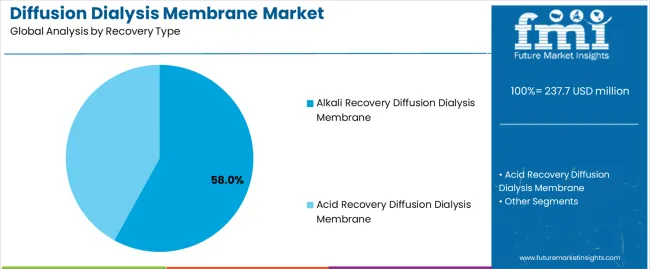
Market Position: Alkali recovery diffusion dialysis membrane systems command the leading position in the diffusion dialysis membrane market with 58% market share through advanced separation features, including superior alkali recovery efficiency, operational reliability, and steel industry optimization that enable manufacturing facilities to achieve optimal resource recovery across diverse industrial and chemical processing environments.
Value Drivers: The segment benefits from steel manufacturer preference for efficient recovery systems that provide consistent alkali extraction performance, reduced chemical costs, and environmental compliance optimization without requiring significant process modifications. Advanced membrane features enable high selectivity, chemical resistance, and integration with existing pickling processes, where recovery efficiency and membrane durability represent critical operational requirements.
Competitive Advantages: Alkali Recovery Diffusion Dialysis Membrane systems differentiate through proven recovery performance, consistent separation characteristics, and integration with industrial waste treatment systems that enhance facility effectiveness while maintaining optimal environmental standards suitable for diverse steel and chemical applications.
Key market characteristics:
Acid Recovery Diffusion Dialysis Membrane systems maintain a 42% market position in the diffusion dialysis membrane market due to their specialized separation properties and chemical processing advantages. These systems appeal to facilities requiring acid recovery with effective metal removal for plating and surface treatment applications. Market growth is driven by chemical processing expansion, emphasizing efficient recovery solutions and waste reduction through optimized membrane designs.

Market Context: Steel applications demonstrate the highest growth rate in the diffusion dialysis membrane market with 30.0% CAGR due to widespread adoption of sustainable pickling processes and increasing focus on waste acid recovery, operational cost reduction, and environmental compliance applications that maximize resource utilization while maintaining processing standards.
Appeal Factors: Steel manufacturers prioritize recovery efficiency, membrane durability, and integration with existing pickling infrastructure that enables coordinated acid-alkali management across multiple processing lines. The segment benefits from substantial environmental investment and circular economy programs that emphasize the acquisition of recovery membranes for waste reduction optimization and cost efficiency applications.
Growth Drivers: Environmental regulations incorporate diffusion dialysis as preferred technology for acid recovery operations, while steel production expansion increases demand for efficient recovery capabilities that comply with discharge standards and minimize chemical consumption.
Market Challenges: Varying pickling processes and solution composition complexity may limit membrane standardization across different steel grades or facility scenarios.
Application dynamics include:
Plating applications capture market share through requirements in electroplating facilities, surface finishing operations, and metal processing plants. These facilities demand acid recovery membranes capable of handling diverse metal ions while providing effective acid extraction and operational consistency capabilities.
Titanium Dioxide Production applications account for market share, including pigment manufacturing, chloride process operations, and chemical synthesis requiring acid recovery for process optimization and waste reduction.
Food Industry applications demonstrate market presence, including citric acid recovery, fermentation processing, and food additive production requiring separation membranes for product purification and waste treatment.
| Category | Factor | Impact | Why It Matters |
|---|---|---|---|
| Driver | Environmental regulations and zero liquid discharge requirements (waste reduction mandates) | ★★★★★ | Requires efficient acid-alkali recovery with minimal environmental discharge for industrial compliance across manufacturing installations. |
| Driver | Rising chemical costs and resource scarcity (circular economy) | ★★★★★ | Turns resource recovery from optional to economically necessary; vendors providing high recovery rates and operational savings gain competitive advantage. |
| Driver | Steel industry expansion and pickling capacity growth (emerging markets) | ★★★★☆ | Manufacturers need cost-effective waste treatment; demand for proven recovery technology expanding addressable market. |
| Restraint | High initial investment and payback period concerns | ★★★★☆ | Small manufacturers defer adoption; increases capital requirements and slows implementation in cost-sensitive operations. |
| Restraint | Membrane fouling and maintenance requirements | ★★★☆☆ | Performance degradation and cleaning complexity limiting operational efficiency in certain applications. |
| Trend | Development of high-performance ion exchange membranes | ★★★★★ | Enhanced selectivity, chemical stability, and lifespan transform performance; advanced materials become core value proposition. |
| Trend | Integration with closed-loop manufacturing systems | ★★★★☆ | Complete resource recovery and zero waste production; circular manufacturing models drive competition toward integrated solutions. |
The diffusion dialysis membrane market demonstrates varied regional dynamics with Growth Leaders including China (5.8% growth rate) and India (5.4% growth rate) driving expansion through steel industry initiatives and environmental compliance development. Steady Performers encompass Germany (4.9% growth rate), United States (4.1% growth rate), and developed regions, benefiting from established chemical industries and advanced environmental technology adoption. Emerging Markets feature Brazil (4.5% growth rate) and developing regions, where industrial initiatives and environmental modernization support consistent growth patterns.
Regional synthesis reveals East Asian markets leading adoption through steel industry expansion and environmental compliance development, while North American countries maintain steady expansion supported by chemical processing advancement and sustainability requirements. European markets show moderate growth driven by circular economy applications and resource efficiency integration trends.

| Region/Country | 2025-2035 Growth | How to win | What to watch out |
|---|---|---|---|
| China | 5.8% | Lead with cost-effective systems | Environmental policy changes; technology standards |
| India | 5.4% | Focus on steel industry partnerships | Infrastructure gaps; technical expertise |
| Germany | 4.9% | Offer premium efficiency membranes | Application complexity; competitive pressure |
| USA | 4.1% | Provide technical support | Regulatory variations; market maturity |
| Brazil | 4.5% | Value-oriented products | Economic volatility; import duties |
| UK | 3.7% | Push sustainability solutions | Market consolidation; Brexit impacts |
| Japan | 3.2% | Focus on quality manufacturing | Conservative adoption; high standards |
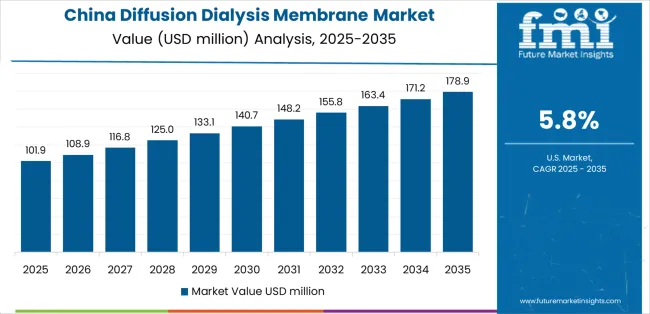
China establishes fastest market growth through aggressive environmental compliance programs and comprehensive steel industry modernization, integrating advanced diffusion dialysis membranes as standard equipment in pickling line and waste treatment installations. The country's 5.8% growth rate reflects government initiatives promoting green manufacturing and domestic separation technology capabilities that mandate the use of recovery membranes in steel and chemical facilities. Growth concentrates in major industrial centers, including Hebei, Jiangsu, and Liaoning, where steel technology development showcases integrated membrane systems that appeal to manufacturers seeking advanced recovery capabilities and environmental compliance applications.
Chinese manufacturers are developing cost-effective membrane solutions that combine domestic production advantages with advanced separation features, including high selectivity and chemical resistance. Distribution channels through environmental equipment suppliers and steel industry service distributors expand market access, while government support for clean production supports adoption across diverse steel and chemical segments.
Strategic Market Indicators:
In Gujarat, Maharashtra, and Tamil Nadu, steel facilities and chemical processing plants are implementing advanced diffusion dialysis membranes as standard equipment for waste acid recovery and environmental compliance applications, driven by increasing government environmental investment and industrial modernization programs that emphasize the importance of resource recovery capabilities. The market holds a 5.4% growth rate, supported by government environmental initiatives and industrial infrastructure development programs that promote recovery membranes for steel and chemical facilities. Indian operators are adopting membrane systems that provide consistent recovery performance and environmental compliance features, particularly appealing in industrial regions where waste treatment and resource efficiency represent critical operational requirements.
Market expansion benefits from growing steel production capabilities and international technology partnerships that enable domestic production of advanced membrane systems for industrial applications. Technology adoption follows patterns established in environmental equipment, where efficiency and performance drive procurement decisions and facility deployment.
Market Intelligence Brief:
Germany establishes environmental technology leadership through comprehensive circular economy programs and advanced chemical processing technology development, integrating diffusion dialysis membranes across steel and chemical applications. The country's 4.9% growth rate reflects established chemical industry relationships and mature environmental technology adoption that supports widespread use of recovery membranes in industrial and processing facilities. Growth concentrates in major industrial centers, including North Rhine-Westphalia, Baden-Wurttemberg, and Bavaria, where environmental technology showcases mature membrane deployment that appeals to manufacturers seeking proven recovery capabilities and sustainability applications.
German equipment providers leverage established distribution networks and comprehensive technical support capabilities, including process optimization programs and environmental certification support that create customer relationships and operational advantages. The market benefits from mature environmental standards and circular economy requirements that mandate recovery membrane use while supporting technology advancement and resource optimization.
Market Intelligence Brief:
United States establishes chemical processing leadership through comprehensive environmental programs and advanced industrial infrastructure development, integrating diffusion dialysis membranes across chemical and steel applications. The country's 4.1% growth rate reflects established chemical industry relationships and mature environmental technology adoption that supports widespread use of recovery membranes in processing and manufacturing facilities. Growth concentrates in major chemical regions, including Texas, Louisiana, and Ohio, where industrial technology showcases mature membrane deployment that appeals to operators seeking proven recovery capabilities and regulatory compliance applications.
American equipment providers leverage established distribution networks and comprehensive technical support capabilities, including process engineering programs and optimization support that create customer relationships and operational advantages. The market benefits from mature environmental standards and waste reduction requirements that support membrane adoption while promoting technology advancement and resource optimization.
Market Intelligence Brief:
Brazil's market expansion benefits from diverse industrial demand, including steel development in Sao Paulo and Minas Gerais, chemical facility upgrades, and government environmental programs that increasingly incorporate recovery membranes for waste treatment applications. The country maintains a 4.5% growth rate, driven by rising industrial activity and increasing recognition of membrane technology benefits, including resource recovery and enhanced environmental compliance.
Market dynamics focus on cost-effective membrane solutions that balance advanced recovery performance with affordability considerations important to Brazilian industrial operators. Growing manufacturing industrialization creates continued demand for modern membrane systems in new facility infrastructure and environmental modernization projects.
Strategic Market Considerations:
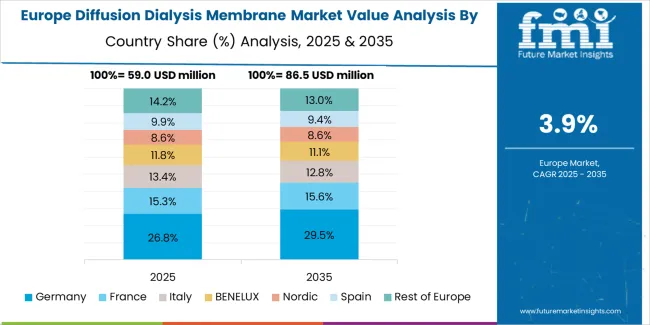
The diffusion dialysis membrane market in Europe is projected to grow from USD 87.2 million in 2025 to USD 134.9 million by 2035, registering a CAGR of 4.5% over the forecast period. Germany is expected to maintain its leadership position with a 36.4% market share in 2025, supported by its advanced chemical processing infrastructure and major industrial centers.
United Kingdom follows with a 22.8% share in 2025, driven by comprehensive environmental programs and chemical industry initiatives. France holds a 19.2% share through specialized steel applications and environmental compliance requirements. Italy commands a 12.6% share, while Spain accounts for 9% in 2025. The rest of Europe region is anticipated to gain momentum, expanding its collective share from 5.4% to 6.2% by 2035, attributed to increasing membrane adoption in Nordic countries and emerging industrial facilities implementing environmental modernization programs.
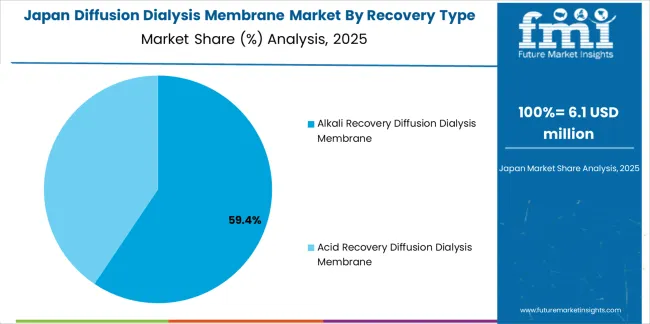
Japan's diffusion dialysis membrane market benefits from established steel manufacturing excellence and comprehensive environmental standards. The country maintains a 3.2% growth rate, supported by government initiatives promoting resource efficiency and environmental technology advancement. Major industrial centers in Tokyo, Osaka, and Nagoya showcase advanced membrane deployment for steel applications and chemical processing. Japanese manufacturers prioritize membrane quality and recovery efficiency, creating demand for premium systems with superior selectivity and chemical resistance. Distribution channels through established industrial equipment networks enable broad market access across steel and chemical segments.

South Korea's market expansion reflects advanced steel manufacturing infrastructure and comprehensive environmental programs. The country demonstrates strong adoption of efficient membrane systems in steel facilities across Pohang, Gwangyang, and Incheon. Growth is driven by steel production initiatives and increasing focus on environmental compliance standards. Korean steel facilities emphasize high-performance membrane solutions with process integration and recovery optimization capabilities. Market development benefits from government environmental technology investment programs and established membrane manufacturing capabilities supporting domestic production of advanced diffusion dialysis systems.
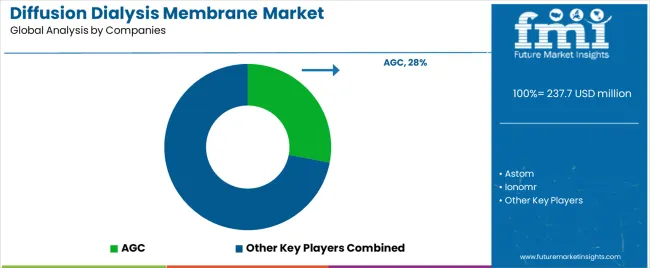
The diffusion dialysis membrane market maintains a moderately consolidated structure with 12-15 credible players, where the top 5-6 companies hold approximately 62-68% by revenue. Market leadership is maintained through technical expertise networks, application support capabilities, and membrane innovation encompassing ion exchange capacity, chemical stability, and selectivity optimization. Competition centers on recovery efficiency, membrane lifespan, and integration with industrial workflows including process control systems and waste treatment facilities.
Basic anion exchange membrane designs and standard recovery systems are commoditizing, shifting competitive advantage toward advanced features such as enhanced chemical resistance, extended operational life, and comprehensive technical support services. Margin opportunities concentrate in custom membrane formulations, process optimization services, and integration into industrial workflows with performance monitoring and lifecycle management programs. Leading manufacturers differentiate through extensive performance validation data supporting recovery efficiency claims, comprehensive technical documentation for process engineers, and responsive application support reducing operational uncertainties.
The competitive landscape features global specialty chemical manufacturers leveraging broad distribution networks and established industrial relationships, specialized ion exchange membrane companies focusing on separation innovation and application expertise, regional industrial equipment suppliers providing localized support and competitive pricing, and emerging advanced materials providers introducing enhanced membrane chemistries and structures. Strategic partnerships between membrane manufacturers and environmental engineering firms are increasing, enabling integrated waste treatment solutions and expanding addressable markets beyond traditional steel applications into chemical processing and specialty manufacturing sectors.
Market dynamics favor participants with proven chemical stability validation, comprehensive technical support networks, and ability to demonstrate economic benefits through recovery efficiency. Membrane development cycles accelerate as performance enhancement and extended lifespan become standard expectations, while chemical resistance certifications and performance standards create barriers to entry protecting established players. Pricing pressure emerges in commodity alkali recovery applications, while premium positioning remains viable for manufacturers offering comprehensive technical solutions with demonstrated recovery performance and integration capabilities supporting industrial sustainability initiatives.
| Item | Value |
|---|---|
| Quantitative Units | USD 237.7 million |
| Recovery Type | Alkali Recovery Diffusion Dialysis Membrane, Acid Recovery Diffusion Dialysis Membrane |
| Application | Steel, Plating, Titanium Dioxide Production, Food Industry, Others |
| Regions Covered | North America, Latin America, Western Europe, Eastern Europe, East Asia, South Asia Pacific, Middle East & Africa |
| Countries Covered | United States, China, Germany, India, United Kingdom, Japan, Brazil, France, South Korea, Italy, and 20+ additional countries |
| Key Companies Profiled | AGC, Astom, Ionomr, Fuma Tech, DESALT, Shandong Tianwei Membrane Technology, Hangzhou Lanran Tech |
| Additional Attributes | Dollar sales by recovery type and application categories, regional adoption trends across East Asia, South Asia Pacific, and North America, competitive landscape with membrane manufacturers and environmental equipment suppliers, industrial operator preferences for recovery efficiency and membrane durability, integration with process control platforms and waste treatment systems, innovations in ion exchange technology and chemical resistance, and development of high-performance membrane solutions with enhanced recovery rates and industrial optimization capabilities. |
The global diffusion dialysis membrane market is estimated to be valued at USD 237.7 million in 2025.
The market size for the diffusion dialysis membrane market is projected to reach USD 362.1 million by 2035.
The diffusion dialysis membrane market is expected to grow at a 4.3% CAGR between 2025 and 2035.
The key product types in diffusion dialysis membrane market are alkali recovery diffusion dialysis membrane and acid recovery diffusion dialysis membrane.
In terms of application, steel segment to command 30.0% share in the diffusion dialysis membrane market in 2025.






Full Research Suite comprises of:
Market outlook & trends analysis
Interviews & case studies
Strategic recommendations
Vendor profiles & capabilities analysis
5-year forecasts
8 regions and 60+ country-level data splits
Market segment data splits
12 months of continuous data updates
DELIVERED AS:
PDF EXCEL ONLINE
Dialysis Water Filters Market Size and Share Forecast Outlook 2025 to 2035
Dialysis Equipment Industry Analysis in the United States Size and Share Forecast Outlook 2025 to 2035
Dialysis Equipment Market Insights - Growth & Forecast 2025 to 2035
Dialysis Induced Anemia Treatment Market Analysis - Size, Share, & Forecast Outlook 2025 to 2035
Dialysis Device and Concentrates Market Growth - Trends & Forecast 2025 to 2035
Hemodialysis and Peritoneal Dialysis Market Size and Share Forecast Outlook 2025 to 2035
Home Dialysis Systems Market Size and Share Forecast Outlook 2025 to 2035
Bipolar Electrodialysis Membrane Market Size and Share Forecast Outlook 2025 to 2035
Continuous Ambulatory Peritoneal Dialysis Bags Market Size and Share Forecast Outlook 2025 to 2035
Membrane Filter Press Solutions Market Size and Share Forecast Outlook 2025 to 2035
Membrane Filter Press Machines Market Size and Share Forecast Outlook 2025 to 2035
Membrane Separation Ammonia Cracker Market Size and Share Forecast Outlook 2025 to 2035
Membrane Separation Technology Market Size and Share Forecast Outlook 2025 to 2035
Membrane Switch Market Size and Share Forecast Outlook 2025 to 2035
Membrane Filtration Systems Market Size and Share Forecast Outlook 2025 to 2035
Membrane Microfiltration Market Size and Share Forecast Outlook 2025 to 2035
Membrane Filter Cartridge Market Size and Share Forecast Outlook 2025 to 2035
Membrane Boxes Market Size and Share Forecast Outlook 2025 to 2035
Membrane Chemicals Market Growth - Trends & Forecast 2025 to 2035
Membrane Air Dryers Market Growth - Trends & Forecast 2025 to 2035

Thank you!
You will receive an email from our Business Development Manager. Please be sure to check your SPAM/JUNK folder too.
Chat With
MaRIA